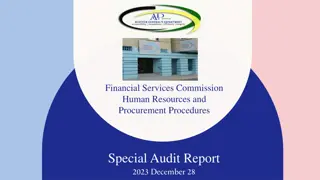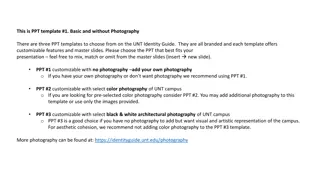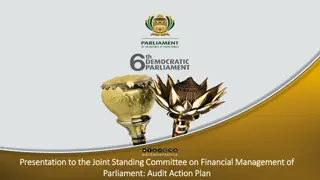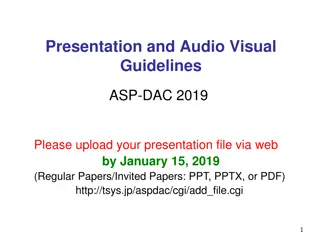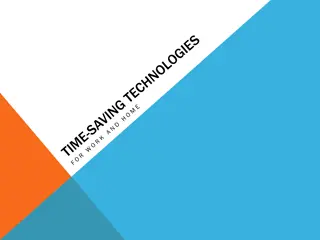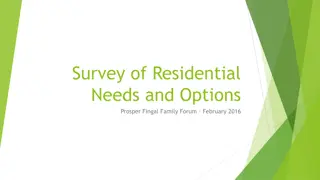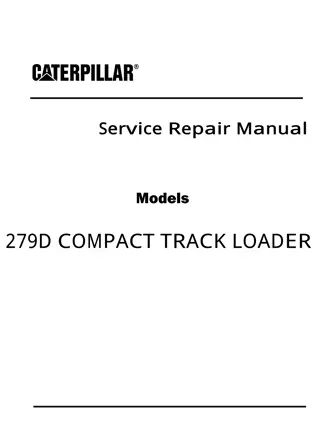
Key Findings from Survey of Colorado Pet Owners Revealed
"Discover key insights from a survey conducted among Colorado pet owners regarding barriers to accessing veterinary care, with a focus on cost and availability. Gain valuable data on perceptions towards telehealth and a proposed mid-level veterinary position. Explore the challenges faced by pet owners and the implications for veterinary care in Colorado." (320 characters)
Download Presentation

Please find below an Image/Link to download the presentation.
The content on the website is provided AS IS for your information and personal use only. It may not be sold, licensed, or shared on other websites without obtaining consent from the author. If you encounter any issues during the download, it is possible that the publisher has removed the file from their server.
You are allowed to download the files provided on this website for personal or commercial use, subject to the condition that they are used lawfully. All files are the property of their respective owners.
The content on the website is provided AS IS for your information and personal use only. It may not be sold, licensed, or shared on other websites without obtaining consent from the author.
E N D
Presentation Transcript
KEY FINDINGS (Januar y 20, 2023 Meeting) SURVEY OF COLORADO PET OWNERS
SECTION 1 EXECUTIVE SUMMARY DFL Pet Owner Survey
Introduction The main research goals of the survey were to: Dumb Friends League retained Corona Insights to conduct a statewide survey of Colorado pet owners as part of the organization s advocacy initiatives for creation of a mid-level veterinary professional position. Corona s survey was designed to provide data and insights as to how pet owners may have been impacted by the state s veterinary workforce shortage, as well as their initial comfort level in potentially being seen by a Veterinary Professional Associate (VPA) or seen through telehealth options. Survey participants were screened to ensure they resided in the state, owned a pet, and made decisions related to the care of a pet(s). The resulting data were weighted by key demographics to ensure a more representative sample of Colorado residents. 556 completed surveys are included in the analysis of this report. Survey responses were collected between January 9th and 13th, 2023. Uncover perceptions of access to veterinary care, potential barriers, and previous care experiences Learn recent use and attitudes toward veterinary telehealth Understand perceptions of a potential new mid- level veterinary practitioner position akin to Physician Assistant Collect key demographics in order to understand the responding population and ensure the results are representative | 3 | DFL Pet Owner Survey
BARRIERS TO ACCESSING VETERINARY CARE IN COLORADO Barrier to Accessing Care Barrier to Accessing Care When exploring challenges to accessing veterinary care for their pets, costs were by far the most consistent barrier and concern encountered. Availability was also a challenge, but one that was more easily surmountable by pet owners. Both of these are further explored in these key findings as well as the full report. Costs When interpreting these findings, please keep the following in mind: These results represent Colorado pet owners (not agricultural or equine) at a statewide level. Results were analyzed by demographics (e.g., income, region) and notable differences are presented here. However, this initial study s sample size is not large enough to draw reliable conclusions for most demographic segments. Veterinary Care Availability | 4 | DFL Pet Owner Survey
Cost is the most significant barrier to receiving veterinary care in Colorado of pet owners mentioned cost in an open- ended question asking for the biggest challenge they faced in finding and receiving veterinary care over the past year, more than any other challenge noted. Open-ended, unaided responses, unveil the strongest barriers as they are the barriers most top-of-mind and therefore likely to have been experienced. 30% 30% We then followed up with specific questions to measure different aspects of each challenge. 24% 24% 47% 47% 53% 53% of pet owners experienced concern over high cost of veterinary visits over high cost of veterinary visits, procedures, prescriptions, and other expenses in the past year concern of pet owners said they were dissatisfied with the cost of quality dissatisfied with the cost of quality veterinary care veterinary care in their area while 34% said they were satisfied were of pet owners said concerns over cost caused them to not take their pet(s) caused them to not take their pet(s) to a veterinarian to a veterinarian for medical care in the past year cost | 5 | DFL Pet Owner Survey
Availability of appointments is an issue for some of the states pet owners of pet owners mentioned availability of appointments in an open-ended question asking for the biggest challenge they faced in finding and receiving veterinary care over the past year, the second most common sentiment. Open-ended, unaided responses, unveil the strongest barriers as they are the barriers most top-of-mind and therefore likely to have been experienced. 18% 18% We then followed up with specific questions to measure different aspects of each challenge. 21% 21% 23% 23% 26% 26% of pet owners experienced long wait times for the next available times for the next available appointment opening appointment opening while seeking veterinary care in the past year long wait of pet owners said being able to schedule timely appointment(s) with schedule timely appointment(s) with their desired veterinarian was difficult their desired veterinarian was difficult in the past year being able to of pet owners said finding and getting finding and getting in to see a veterinarian for urgent or in to see a veterinarian for urgent or emergency medical care was difficult emergency medical care was difficult in the past year | 6 | DFL Pet Owner Survey
Colorado pet owners with lower household incomes faced greater barriers to accessing care, especially related to cost The chart on the left presents the percentage of Colorado pet owners who said they were strongly satisfied with their ability to find and receive quality veterinary care in their area segmented by household income. Pet owners with the lowest household incomes were much less likely to be strongly satisfied (25%) than those with the highest incomes (60%). Additionally, pet owners with lower incomes had distinct experiences in the following areas: > Pet owners with household incomes below $50,000 a year were twice as likely (44%) as others (22%) to mention high costs as the biggest challenge they faced in finding and receiving veterinary care in the past year. > Those with household incomes below $50,000 a year were more likely (37%) to say that concerns over the possible high cost of care caused them to not take their pet(s) to a veterinarian in the last year compared to 16% of pet owners with higher incomes. > Pet owners with household incomes below $30,000 a year were more likely to say they found it difficult to find a desired veterinarian that was accepting new patients (37%) than others (14%) within the past year. Satisfaction With Ability to Find and Receive Quality Veterinary Care in Your Area 100% 40% 75% 52% 58% 64% 75% 50% 60% 25% 48% 42% 36% 25% 0% $0 - $29,999 $30,000 to $49,999 $50,000 to $99,999 $100,000 to $149,999 $150,000 or more Strongly satisfied Less than strongly satisfied | 7 | DFL Pet Owner Survey
Pet owners who lived outside the front range were more likely to say their biggest challenge over the past year was a lack of conveniently located vet offices Biggest Challenge in Finding and Receiving Care Over The Last 12 Months Was: No Conveniently Located Vet Offices/Few Options Nearby Nearly one out of five (18%) pet owners living outside the front range mentioned a lack of conveniently located vet offices in an open-ended question asking for the biggest challenge they faced in finding and receiving veterinary care over the past year. Other differences by region of residence included: > Pet owners living outside of the front range were more likely to say they were dissatisfied with their ability to find and receive quality veterinary care in their area (19%) than those living in the Denver metro area (9%), though this difference was not statistically significant. > Front range pet owners were more likely to say they would be comfortable using veterinary telehealth if it were allowed under state law (52%) than those outside the front range (39%), though this difference was not statistically significant. Denver Metro 4% North and South Front Range 6% Mountains and Plains 18% | 8 | DFL Pet Owner Survey
POSSIBLE SOLUTIONS TO INCREASE ACCESS Possible Solutions Tested Possible Solutions Tested After understanding possible barriers to accessing veterinary care for pets in Colorado, the survey explored two potential solutions that could help increase access. This included telehealth options and the possible creation of a new licensed, mid-level professional. Support and comfort with both were generally high with few opposed. These are summarized in the following slides and further expanded on in the full report. Telehealth Veterinary Care New licensed position | 9 | DFL Pet Owner Survey
While few pet owners have experience with telehealth veterinary care, half said they would be comfortable using it if it were allowed by state law Comfort Using Veterinary Telehealth if it Was Allowed Under State Law 100% > 6% of Colorado pet owners said they had ever received veterinary care through telehealth. > Half of the state s pet owners (50%) said they would be comfortable using veterinary telehealth if it was allowed under state law. > Pet owners under the age of 55 were more likely to say they would feel comfortable using veterinary telehealth in this scenario (58%) than those 55 and older (35%). Not shown. Very comfortable, 20% 50% 50% Very or Somewhat Comfortable 75% Somewhat comfortable, 30% 50% Neither uncomfortable nor comfortable, 18% Somewhat uncomfortable, 16% 25% Very uncomfortable, 7% Don t know, 9% 0% | 10 | DFL Pet Owner Survey
Two of three Colorado pet owners supported the idea of a new licensed, mid-level professional Support For Colorado Creating a New Licensed, Mid- Level Professional Who Would Work Under The Supervision of a Veterinarian Pet owners were first asked would they oppose or support Colorado creating a new licensed, mid-level professional who would work under the supervision of a veterinarian without any additional background or context for this new position. 100% Strongly support, 30% 67% 67% 75% Strongly or Somewhat Support new position > Two thirds of pet owners (67%) said they would support the creation of this new position and only 5% said they would oppose its creation. > About one quarter of pet owners (23%) said they neither opposed or supported the creation of this position and an additional 5% said they did not know. Somewhat support, 37% 50% Neither oppose nor support, 23% 25% 4% 4% 3% Strongly or Somewhat Oppose 1% Don t know, 5% 0% | 11 | DFL Pet Owner Survey
Four out of five pet owners said they would be comfortable having their pet seen by a licensed VPA Next, they were asked how comfortable they would be having their pet seen by a licensed Veterinarian Professional Assistant (VPA). Respondents were asked to read the following before answering: Colorado faces a severe veterinary workforce shortage. In response, Colorado animal experts are proposing the creation of a mid-level Veterinary Professional Associate position. Similar to a Physician Assistant in human medicine, a veterinary PA would be a master s degree-level professional who works under the direct supervision of a veterinarian to examine pets, diagnose minor conditions, perform routine surgeries and lead healthcare teams. A veterinary PA position could create more access and lower costs for Coloradoans to take care of their pets. Comfort Having Your Pet Seen by a Licensed Veterinarian Professional Assistant (VPA) 100% Very comfortable, 42% 75% 80% 80% Very or Somewhat Comfortable 50% Somewhat comfortable, 38% > Four out of five (80%) said they would be comfortable and just 7% said they would be uncomfortable having their pet seen by a VPA. > Most Colorado pet owners had seen a PA for their own care in the past (72%), and these individuals were more likely to be very comfortable (87%) with their pet seeing a VPA than others (73%). Not shown. 25% Neither 7% 7% uncomfortable nor comfortable, 11% Very or Somewhat Uncomfortable 4% 3% Don t know, 3% 0% | 12 | DFL Pet Owner Survey
1401 Lawrence Street Suite 1600 Denver, CO 80202 303.894.8246 CoronaInsights.com




